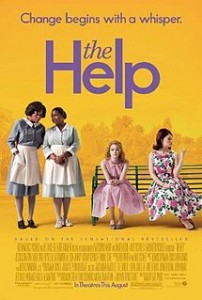 The book, called The Help written by Kathryn Stockett is the basis for a new movie now playing featuring Cecily Tyson, Emma Stone, Mike Vogel, Bryce Dallas Howard, Viola Davis, Octavia Spencer, and Allison Janney. The book has been published now in 35 countries, stayed on the NY Times bestseller list for 100 weeks and has sold 5 million copies. That would be more impressive if read alongside the fact that it was rejected by at least 60 literary agents before Susan Ramer agreed to represent Stockett. I saw the movie today, and I can say that it was an experience. I suspect that a series of prestigious awards await the director and the actors for a brilliant performance.
The book, called The Help written by Kathryn Stockett is the basis for a new movie now playing featuring Cecily Tyson, Emma Stone, Mike Vogel, Bryce Dallas Howard, Viola Davis, Octavia Spencer, and Allison Janney. The book has been published now in 35 countries, stayed on the NY Times bestseller list for 100 weeks and has sold 5 million copies. That would be more impressive if read alongside the fact that it was rejected by at least 60 literary agents before Susan Ramer agreed to represent Stockett. I saw the movie today, and I can say that it was an experience. I suspect that a series of prestigious awards await the director and the actors for a brilliant performance.
Most contemporary commentaries on the situation in the Jim Crow old South usually omit the complexity of the human relationships that defined those times. What the movie provides if not altogether new is a look at the extremely complex and nuanced relationships between southern belles and their housemaids. Every household in Mississippi in those days had at least one maid that helped raise the little white children of the house for very meagre payment. Many of them lived however under a more hostile work condition that was as complex as it was illuminating of the mutual dependence that defined the relationships. The movie did a brilliant job of illustrating the complexities with as much humour and passion as it deserved.
It is an important new addition to the dialogue among generations of people brought up under segregation and racial tensions of the sixties. It showed also that the South was not just one homogeneous society of racist people but a collection of real humans with varying levels of courage, passion, wickedness, indifference, and hope. One question I asked as I left the fully packed theatre to a sight of an even longer line of people waiting to come in for the next showing is whether the message of the movie is received the same way across board. As much as it moves us to emotions and to laughter with the scenes and dialogues, it might be good to ask if the message blacks and whites take away from the theatre are the same. I wouldn’t know. There were only a handful of black people in the cinema.
 As regards race relations, the movie doesn’t say anything new. It only offers new perspectives, but that is already controversial. Some people have already advocated boycotting the movie on the basis of its being written by a white person and portraying old black female stereotypes. Last weekend at another house party, I asked one of the women who had initially sparked my interest in the story whether she was going to go see it now that it is in the movies. “No,” she said, “but I’d be thinking about it.” She didn’t read the book either. She said she had grown up in Mississippi in the 60s and would not need a book to tell her how bad it was. What is not in doubt is that this is an important addition to the racial dialogue in the country.
As regards race relations, the movie doesn’t say anything new. It only offers new perspectives, but that is already controversial. Some people have already advocated boycotting the movie on the basis of its being written by a white person and portraying old black female stereotypes. Last weekend at another house party, I asked one of the women who had initially sparked my interest in the story whether she was going to go see it now that it is in the movies. “No,” she said, “but I’d be thinking about it.” She didn’t read the book either. She said she had grown up in Mississippi in the 60s and would not need a book to tell her how bad it was. What is not in doubt is that this is an important addition to the racial dialogue in the country.
The author, the director, and the actors deserve commendation for their brilliant work.
____________
More reviews of the work below.
Talking with Kathryn Stockett. (Daily Mail)
Help with History (Miami Herald)